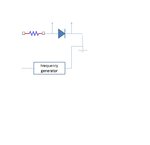kdg007
Full Member level 3

so, i simply connected a LED (forward voltage of 3.3v) with a series resistor (85 ohm), that should give 20mA of current to the LED.
-
then , connected the frequency generator to the series circuit, the LED worked pretty good at about 900kHz .. but when i kept to 10Mhz or more than 3-4 Mhz... the lED just stop working.... why is that ?
-
how to determine the maximum frequency of the LED?
-
i know LED cannot work for higher frequencies but what is the possible explanation for that ? is that the depletion region ? or any losses effect?
-
then , connected the frequency generator to the series circuit, the LED worked pretty good at about 900kHz .. but when i kept to 10Mhz or more than 3-4 Mhz... the lED just stop working.... why is that ?
-
how to determine the maximum frequency of the LED?
-
i know LED cannot work for higher frequencies but what is the possible explanation for that ? is that the depletion region ? or any losses effect?



